Marketing Report: Analyzing Health Express' Growth Opportunities
VerifiedAdded on 2022/08/28
|5
|1083
|21
Report
AI Summary
This report analyzes the marketing challenges and opportunities for Health Express, an urgent care center. It begins by examining the competitive landscape, highlighting differences between Health Express and competitors like retail clinics and other urgent care providers. The report then explores various marketing strategies, including promotional activities, patient acquisition, and service differentiation, considering market segmentation and the importance of prioritizing patient needs, especially in emergency situations. It also addresses the need for efficient traffic management and the use of social media for information dissemination. The report emphasizes the importance of continuous improvement, capability analysis, and add-on services, such as Botox, to increase revenue. The analysis considers the impact of marketing vehicles, budget allocation, and regulatory compliance. The report concludes by emphasizing the importance of understanding patient willingness and preferences in making decisions about service offerings and marketing approaches.
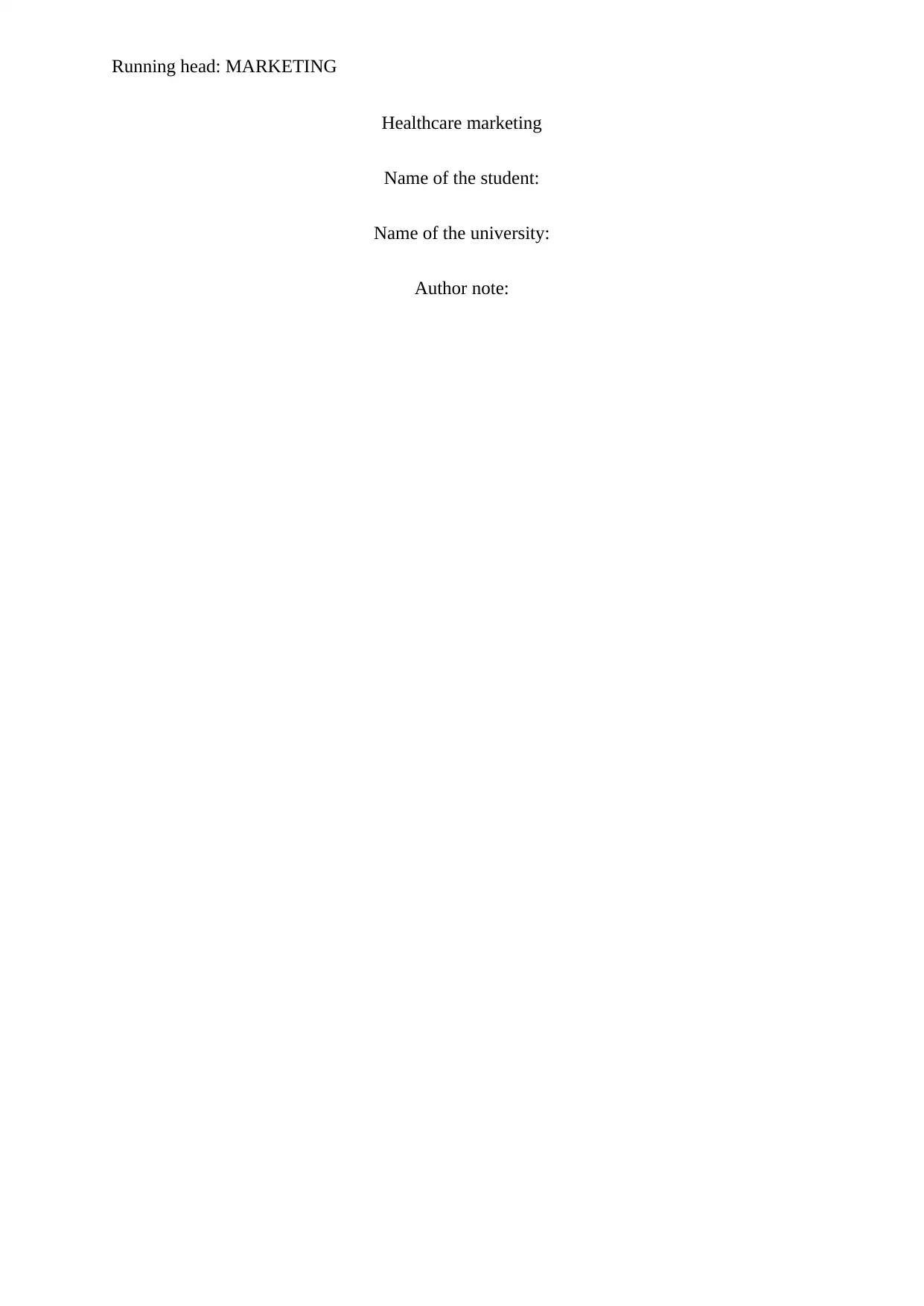
Running head: MARKETING
Healthcare marketing
Name of the student:
Name of the university:
Author note:
Healthcare marketing
Name of the student:
Name of the university:
Author note:
Paraphrase This Document
Need a fresh take? Get an instant paraphrase of this document with our AI Paraphraser
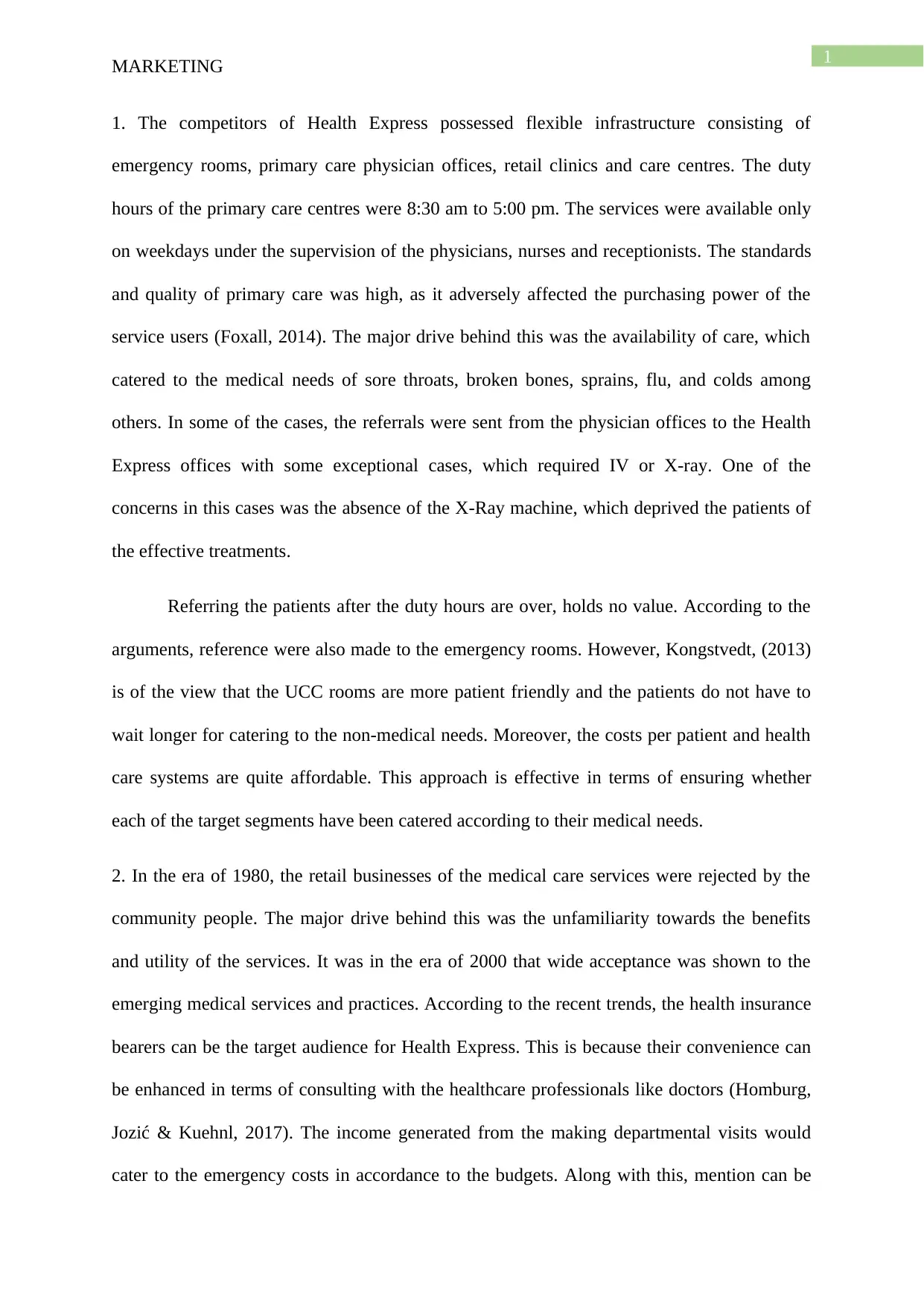
1
MARKETING
1. The competitors of Health Express possessed flexible infrastructure consisting of
emergency rooms, primary care physician offices, retail clinics and care centres. The duty
hours of the primary care centres were 8:30 am to 5:00 pm. The services were available only
on weekdays under the supervision of the physicians, nurses and receptionists. The standards
and quality of primary care was high, as it adversely affected the purchasing power of the
service users (Foxall, 2014). The major drive behind this was the availability of care, which
catered to the medical needs of sore throats, broken bones, sprains, flu, and colds among
others. In some of the cases, the referrals were sent from the physician offices to the Health
Express offices with some exceptional cases, which required IV or X-ray. One of the
concerns in this cases was the absence of the X-Ray machine, which deprived the patients of
the effective treatments.
Referring the patients after the duty hours are over, holds no value. According to the
arguments, reference were also made to the emergency rooms. However, Kongstvedt, (2013)
is of the view that the UCC rooms are more patient friendly and the patients do not have to
wait longer for catering to the non-medical needs. Moreover, the costs per patient and health
care systems are quite affordable. This approach is effective in terms of ensuring whether
each of the target segments have been catered according to their medical needs.
2. In the era of 1980, the retail businesses of the medical care services were rejected by the
community people. The major drive behind this was the unfamiliarity towards the benefits
and utility of the services. It was in the era of 2000 that wide acceptance was shown to the
emerging medical services and practices. According to the recent trends, the health insurance
bearers can be the target audience for Health Express. This is because their convenience can
be enhanced in terms of consulting with the healthcare professionals like doctors (Homburg,
Jozić & Kuehnl, 2017). The income generated from the making departmental visits would
cater to the emergency costs in accordance to the budgets. Along with this, mention can be
MARKETING
1. The competitors of Health Express possessed flexible infrastructure consisting of
emergency rooms, primary care physician offices, retail clinics and care centres. The duty
hours of the primary care centres were 8:30 am to 5:00 pm. The services were available only
on weekdays under the supervision of the physicians, nurses and receptionists. The standards
and quality of primary care was high, as it adversely affected the purchasing power of the
service users (Foxall, 2014). The major drive behind this was the availability of care, which
catered to the medical needs of sore throats, broken bones, sprains, flu, and colds among
others. In some of the cases, the referrals were sent from the physician offices to the Health
Express offices with some exceptional cases, which required IV or X-ray. One of the
concerns in this cases was the absence of the X-Ray machine, which deprived the patients of
the effective treatments.
Referring the patients after the duty hours are over, holds no value. According to the
arguments, reference were also made to the emergency rooms. However, Kongstvedt, (2013)
is of the view that the UCC rooms are more patient friendly and the patients do not have to
wait longer for catering to the non-medical needs. Moreover, the costs per patient and health
care systems are quite affordable. This approach is effective in terms of ensuring whether
each of the target segments have been catered according to their medical needs.
2. In the era of 1980, the retail businesses of the medical care services were rejected by the
community people. The major drive behind this was the unfamiliarity towards the benefits
and utility of the services. It was in the era of 2000 that wide acceptance was shown to the
emerging medical services and practices. According to the recent trends, the health insurance
bearers can be the target audience for Health Express. This is because their convenience can
be enhanced in terms of consulting with the healthcare professionals like doctors (Homburg,
Jozić & Kuehnl, 2017). The income generated from the making departmental visits would
cater to the emergency costs in accordance to the budgets. Along with this, mention can be
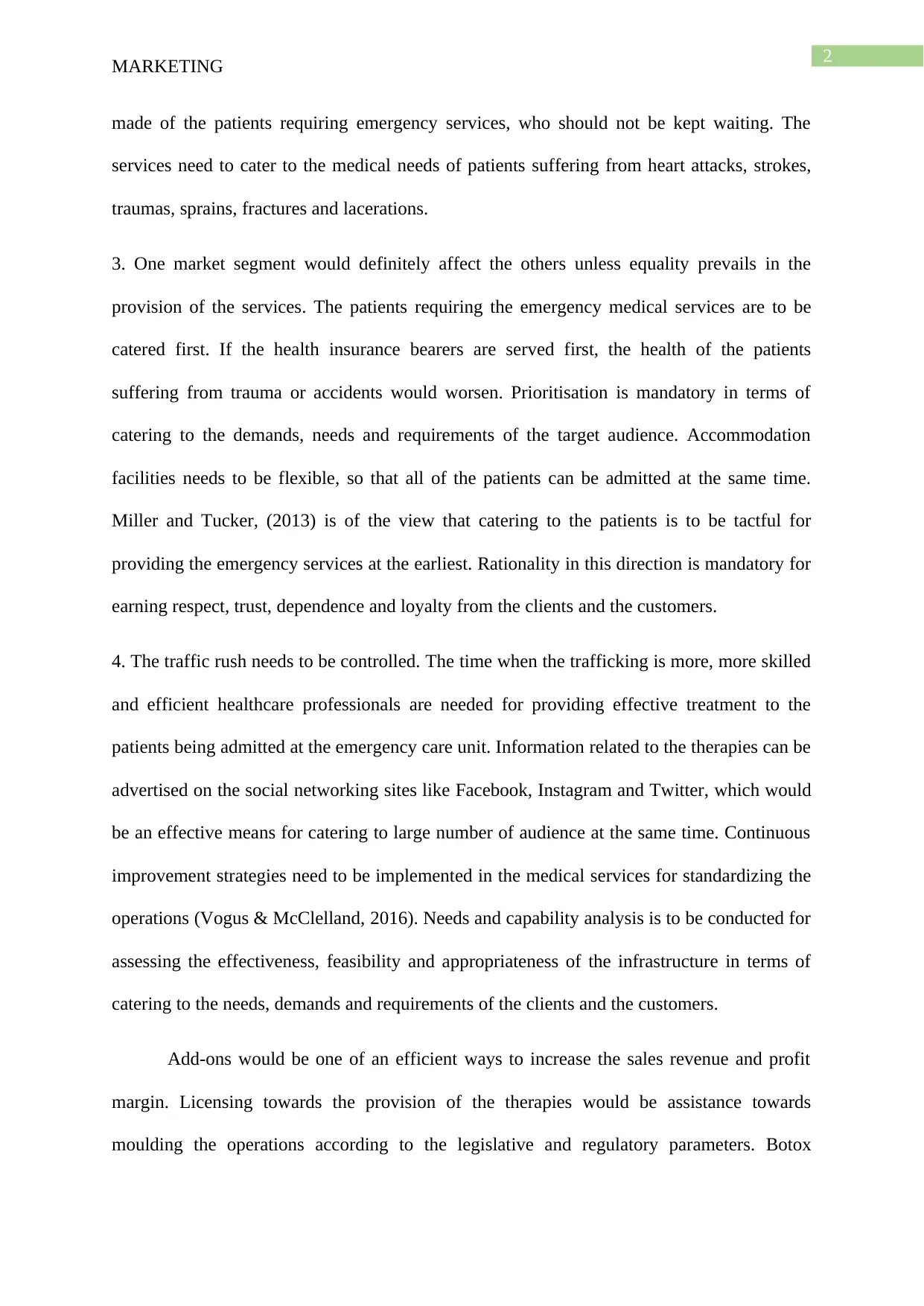
2
MARKETING
made of the patients requiring emergency services, who should not be kept waiting. The
services need to cater to the medical needs of patients suffering from heart attacks, strokes,
traumas, sprains, fractures and lacerations.
3. One market segment would definitely affect the others unless equality prevails in the
provision of the services. The patients requiring the emergency medical services are to be
catered first. If the health insurance bearers are served first, the health of the patients
suffering from trauma or accidents would worsen. Prioritisation is mandatory in terms of
catering to the demands, needs and requirements of the target audience. Accommodation
facilities needs to be flexible, so that all of the patients can be admitted at the same time.
Miller and Tucker, (2013) is of the view that catering to the patients is to be tactful for
providing the emergency services at the earliest. Rationality in this direction is mandatory for
earning respect, trust, dependence and loyalty from the clients and the customers.
4. The traffic rush needs to be controlled. The time when the trafficking is more, more skilled
and efficient healthcare professionals are needed for providing effective treatment to the
patients being admitted at the emergency care unit. Information related to the therapies can be
advertised on the social networking sites like Facebook, Instagram and Twitter, which would
be an effective means for catering to large number of audience at the same time. Continuous
improvement strategies need to be implemented in the medical services for standardizing the
operations (Vogus & McClelland, 2016). Needs and capability analysis is to be conducted for
assessing the effectiveness, feasibility and appropriateness of the infrastructure in terms of
catering to the needs, demands and requirements of the clients and the customers.
Add-ons would be one of an efficient ways to increase the sales revenue and profit
margin. Licensing towards the provision of the therapies would be assistance towards
moulding the operations according to the legislative and regulatory parameters. Botox
MARKETING
made of the patients requiring emergency services, who should not be kept waiting. The
services need to cater to the medical needs of patients suffering from heart attacks, strokes,
traumas, sprains, fractures and lacerations.
3. One market segment would definitely affect the others unless equality prevails in the
provision of the services. The patients requiring the emergency medical services are to be
catered first. If the health insurance bearers are served first, the health of the patients
suffering from trauma or accidents would worsen. Prioritisation is mandatory in terms of
catering to the demands, needs and requirements of the target audience. Accommodation
facilities needs to be flexible, so that all of the patients can be admitted at the same time.
Miller and Tucker, (2013) is of the view that catering to the patients is to be tactful for
providing the emergency services at the earliest. Rationality in this direction is mandatory for
earning respect, trust, dependence and loyalty from the clients and the customers.
4. The traffic rush needs to be controlled. The time when the trafficking is more, more skilled
and efficient healthcare professionals are needed for providing effective treatment to the
patients being admitted at the emergency care unit. Information related to the therapies can be
advertised on the social networking sites like Facebook, Instagram and Twitter, which would
be an effective means for catering to large number of audience at the same time. Continuous
improvement strategies need to be implemented in the medical services for standardizing the
operations (Vogus & McClelland, 2016). Needs and capability analysis is to be conducted for
assessing the effectiveness, feasibility and appropriateness of the infrastructure in terms of
catering to the needs, demands and requirements of the clients and the customers.
Add-ons would be one of an efficient ways to increase the sales revenue and profit
margin. Licensing towards the provision of the therapies would be assistance towards
moulding the operations according to the legislative and regulatory parameters. Botox
⊘ This is a preview!⊘
Do you want full access?
Subscribe today to unlock all pages.

Trusted by 1+ million students worldwide
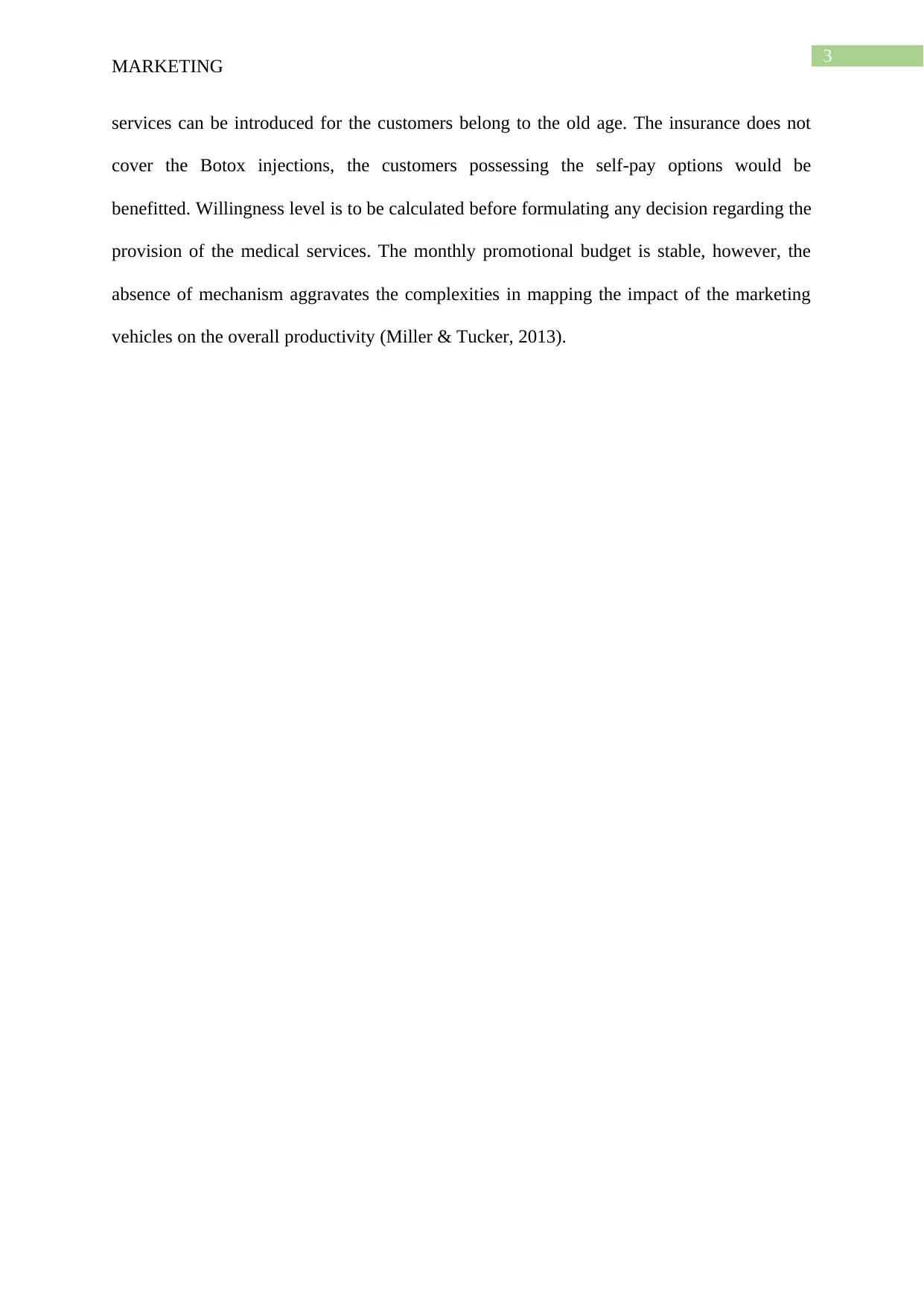
3
MARKETING
services can be introduced for the customers belong to the old age. The insurance does not
cover the Botox injections, the customers possessing the self-pay options would be
benefitted. Willingness level is to be calculated before formulating any decision regarding the
provision of the medical services. The monthly promotional budget is stable, however, the
absence of mechanism aggravates the complexities in mapping the impact of the marketing
vehicles on the overall productivity (Miller & Tucker, 2013).
MARKETING
services can be introduced for the customers belong to the old age. The insurance does not
cover the Botox injections, the customers possessing the self-pay options would be
benefitted. Willingness level is to be calculated before formulating any decision regarding the
provision of the medical services. The monthly promotional budget is stable, however, the
absence of mechanism aggravates the complexities in mapping the impact of the marketing
vehicles on the overall productivity (Miller & Tucker, 2013).
Paraphrase This Document
Need a fresh take? Get an instant paraphrase of this document with our AI Paraphraser
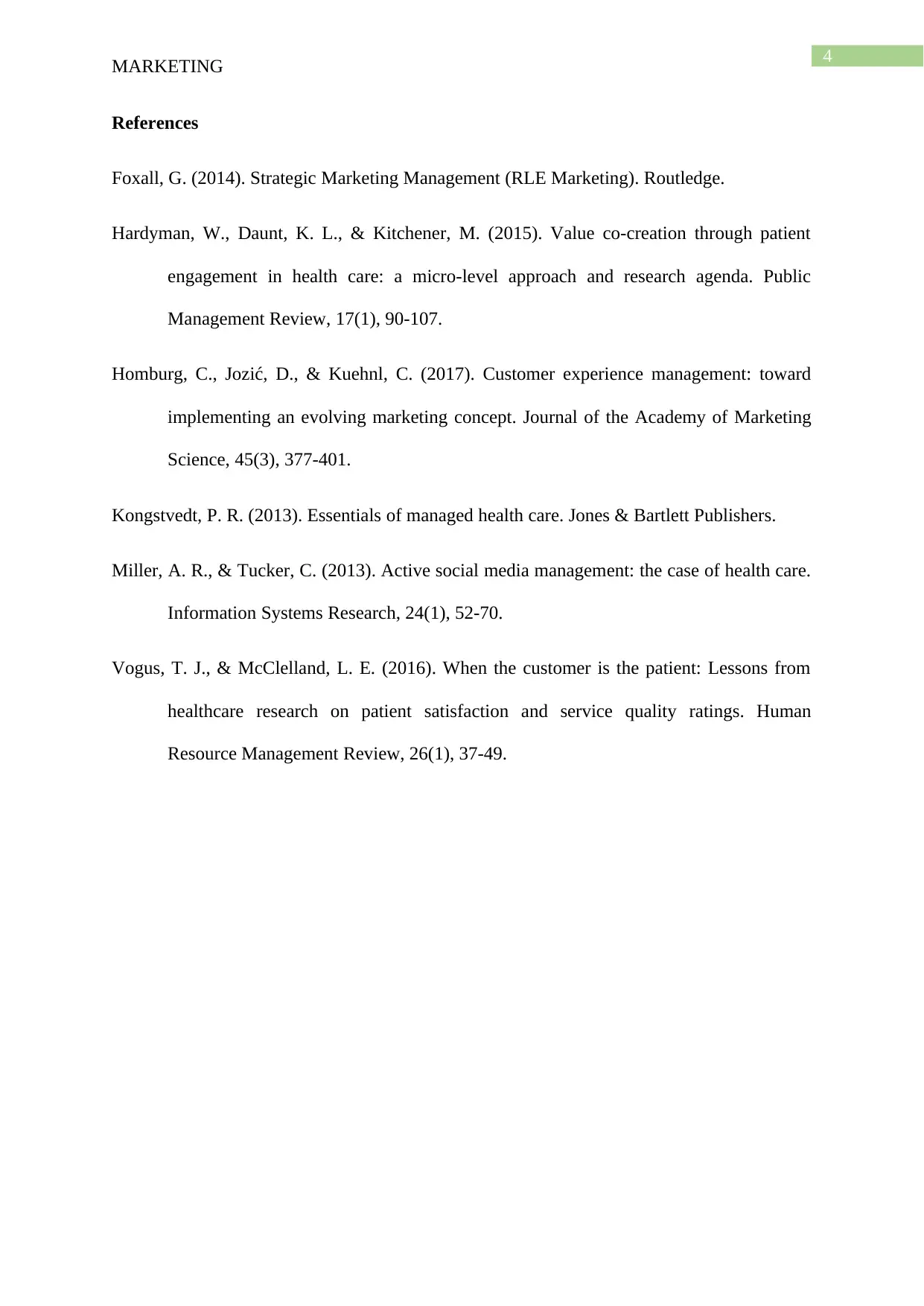
4
MARKETING
References
Foxall, G. (2014). Strategic Marketing Management (RLE Marketing). Routledge.
Hardyman, W., Daunt, K. L., & Kitchener, M. (2015). Value co-creation through patient
engagement in health care: a micro-level approach and research agenda. Public
Management Review, 17(1), 90-107.
Homburg, C., Jozić, D., & Kuehnl, C. (2017). Customer experience management: toward
implementing an evolving marketing concept. Journal of the Academy of Marketing
Science, 45(3), 377-401.
Kongstvedt, P. R. (2013). Essentials of managed health care. Jones & Bartlett Publishers.
Miller, A. R., & Tucker, C. (2013). Active social media management: the case of health care.
Information Systems Research, 24(1), 52-70.
Vogus, T. J., & McClelland, L. E. (2016). When the customer is the patient: Lessons from
healthcare research on patient satisfaction and service quality ratings. Human
Resource Management Review, 26(1), 37-49.
MARKETING
References
Foxall, G. (2014). Strategic Marketing Management (RLE Marketing). Routledge.
Hardyman, W., Daunt, K. L., & Kitchener, M. (2015). Value co-creation through patient
engagement in health care: a micro-level approach and research agenda. Public
Management Review, 17(1), 90-107.
Homburg, C., Jozić, D., & Kuehnl, C. (2017). Customer experience management: toward
implementing an evolving marketing concept. Journal of the Academy of Marketing
Science, 45(3), 377-401.
Kongstvedt, P. R. (2013). Essentials of managed health care. Jones & Bartlett Publishers.
Miller, A. R., & Tucker, C. (2013). Active social media management: the case of health care.
Information Systems Research, 24(1), 52-70.
Vogus, T. J., & McClelland, L. E. (2016). When the customer is the patient: Lessons from
healthcare research on patient satisfaction and service quality ratings. Human
Resource Management Review, 26(1), 37-49.
1 out of 5
Related Documents
Your All-in-One AI-Powered Toolkit for Academic Success.
+13062052269
info@desklib.com
Available 24*7 on WhatsApp / Email
![[object Object]](/_next/static/media/star-bottom.7253800d.svg)
Unlock your academic potential
Copyright © 2020–2025 A2Z Services. All Rights Reserved. Developed and managed by ZUCOL.





